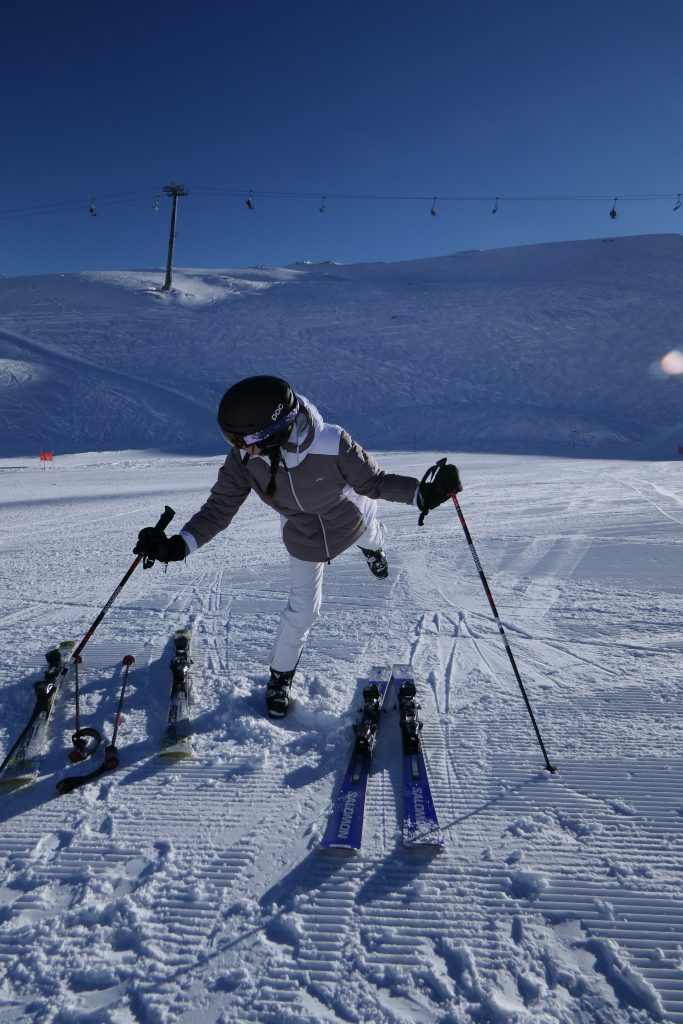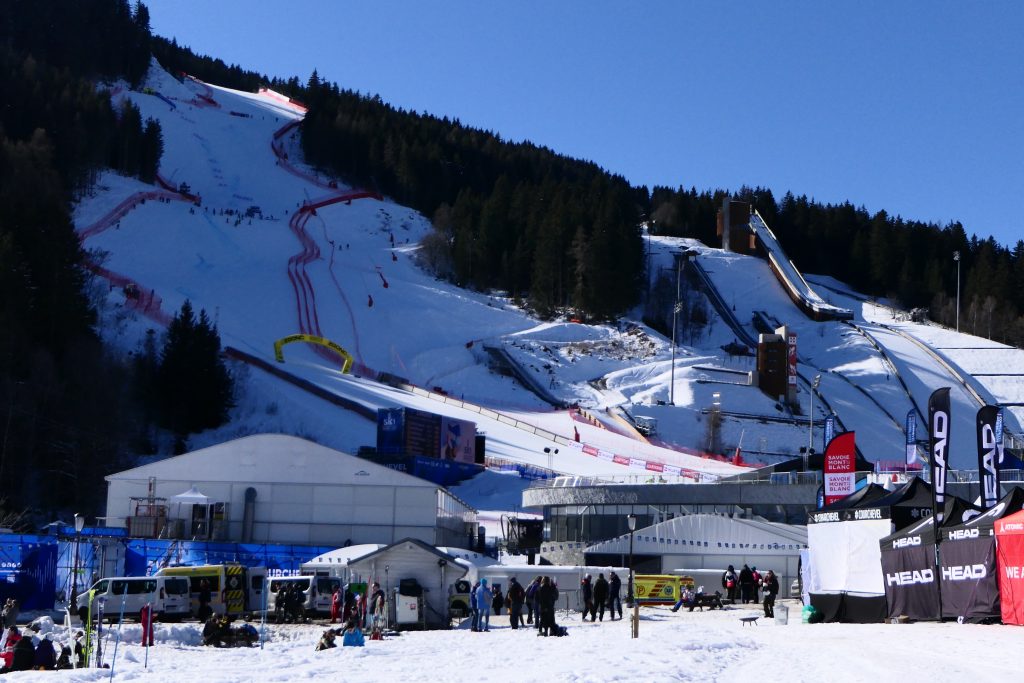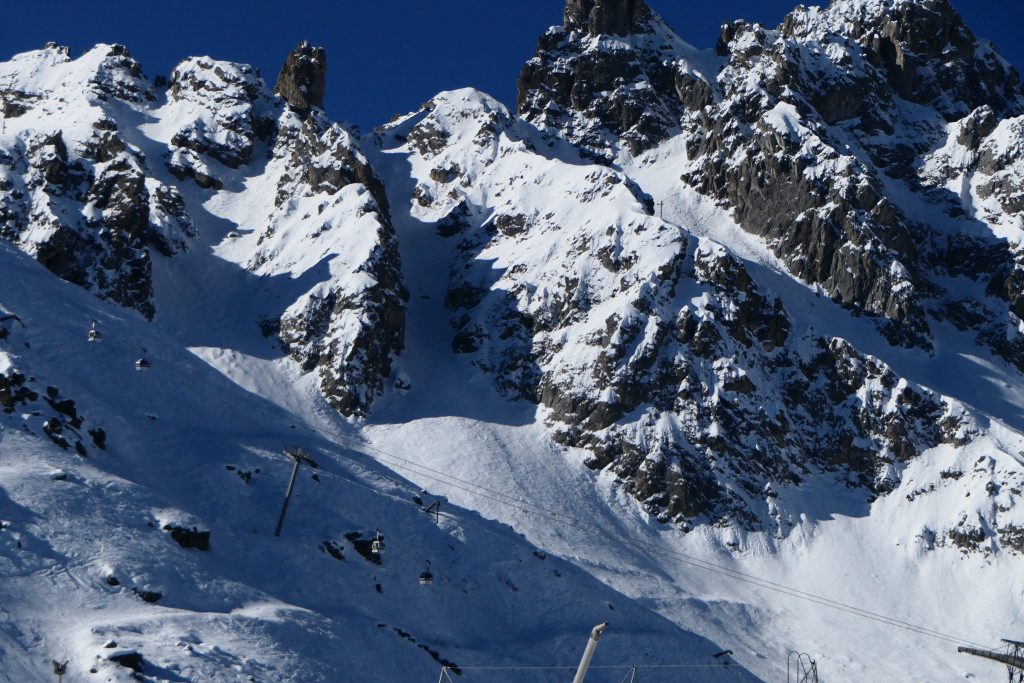Karen was asked the fatal question : “What do you do to start a turn?” Response?… guess! If somebody asked me what I do to stay upright on a bicycle I’d expect to have no answer because nobody taught me how to ride a bicycle, it was all just trial and error – lots of scraped knees etc. The invisible elephant in the room here is that everyone I ask this question has actually been taught to ski.
(The response was “Transfer weight” – but not sure how!)
Prior to getting on the snow Karen was subjected to an explanation of dynamics. The following link has a basic explanation of dynamics and the appropriate exercises…
http://madeinmountains.com/dynamics/
We actually began with work on the pivot – but rapidly moved on to dynamics. There’s a detailed program for understanding the pivot at this link: http://madeinmountains.com/pivo/
Skis work in two different ways – either running forward like a bicycle and requiring a push/fall laterally into the turn of the centre of mass – so that the ski by changing edge angle cuts in front of the falling trajectory and lifts the skier back up again – this being defined in physics as “Dynamics” – the physics of disequilibrium. More specifically this is “free flow” dynamics because only the centre of mass and the supporting ski/skis are interacting.
The second way a ski works is when travelling sideways – from a side slip. Here the front of the ski is required to “swing” into a turn. (video below) The dynamics are constrained by putting weight on the ski pole downhill of the body – thus keeping the supporting ski on its uphill edge as long as possible enabling it to swing inward and eventually do so for the entire turn. This is the actual purpose of a ski pole – controlling the centre of mass.
My objective today rapidly became clear in that Karen needed a blend of both types of ski function to improve her control on steep narrow slopes. I’m not recounting every single detail here because most of that is covered in the links provided – the separation of the edge of the foot from the edge of the ski etc.
Side slipping with “joystick” control was used to demonstrate the sensitivity of the skis to tiny movements of the centre of mass. Skating was used to demonstrate clear dynamics.
- One leg (outside of the new turn)
- Foot on inside edge
- Adductors tensioned to form a solid connection with the centre of mass
- Extend leg (accelerator pedal) to push centre of mass (effectively a skating action)
- Drive inward to the turn centre even harder toward the end of the turn (ball on a string analogy)
- Pull the hip backward through the second half of the turn (to stop it rotating outward)
Dynamics is the language of the skis and essentially it generates inclination…

Hip Angulation is about control of rotation of the pelvis (NOT the shoulders!) Remember the abdominal postural muscles reflex! Hip Angulation requires a tilt forward of the upper body over one single hip joint and then a (counter) rotation of the upper body – but also including a pull back of the hip so that there’s a stretch between the lower front rib and the pelvis on that side.

The next photo is when Inclination and hip-angulation are properly combined.
Outside leg extended and a “full gas” skating action here.
The foot of the inside ski must also be on its inside edge so the knee can be brought to the centre-line of the body – mainly for the purpose of keeping control over the pelvis.
More on Hip Angulation here: http://madeinmountains.com/chiskiing/

Karen was responsive to every aspect of the session. Start most turns from the uphill edge of the uphill ski and when on steeps do this with more sideways motion than forward motion – limit the “free flow” dynamics on steeps – use the ski pole for controlling the centre of mass and keeping the upper body tilted forward. Watch that you don’t kill the dynamics from a solid turn completion by going into a traverse when finishing a turn on the left foot. Finish the turn (almost back uphill) to control speed then you come over the top of your downhill ski (to some degree) – while still on it – or for a better pivot you just don’t come all the way over before stomping on the new uphill ski.
Skiing is absolutely NOT about going fast on pistes – it’s about quality of feeling and using “line” on the mountain to control speed. Unfortunately very few skiers ever realise this.
Video Feedback
First clip shows definite development of dynamics.
The skating clip shows good body and arm position with proper movement of the centre of mass and active use of the feet.
The “poles” clip shows good basic arm carriage.
Last clip on the steep shows an improved control due to swinging the skis inward instead of pushing the tails outward and rushing the starts of the turns. Just finish the turns almost back up the hill to get the skis to lift the body up out of the turns.
More hip angulation needed and more belief that the fronts of the skis work too!
Today’s Views…



